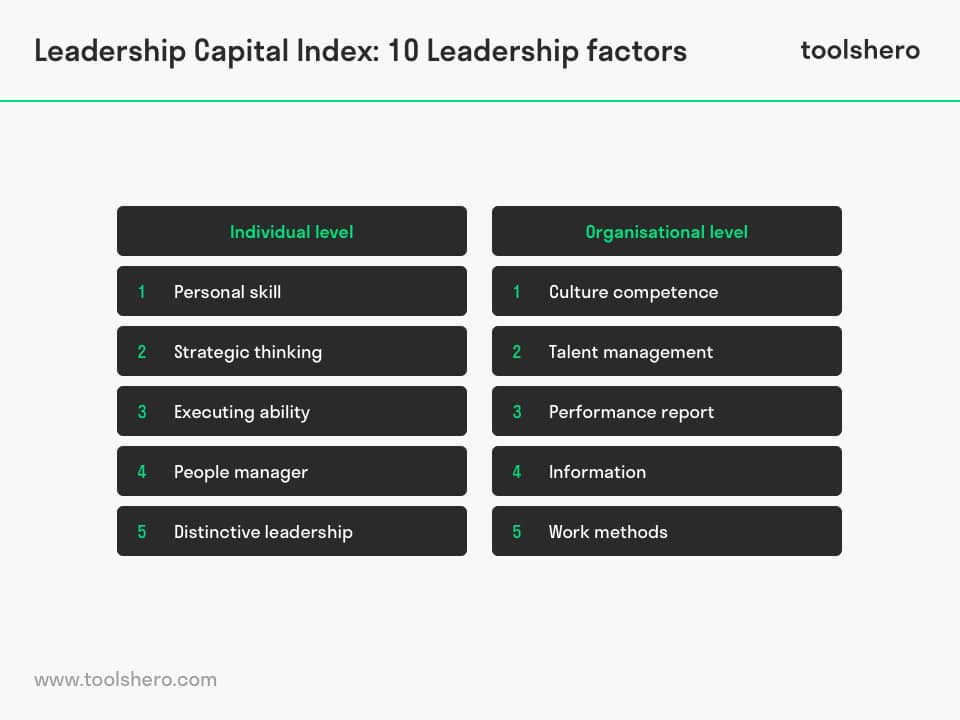Leadership Capital Index (Ulrich)

Leadership Capital Index: this article describes the Leadership Capital Index by Dave Ulrich in a practical way. After reading you will understand the definition and basics of this powerful leadership measurement method.
What is the Leadership Capital Index?
American management and organisation professor Dave Ulrich wrote the book ‘Leadership Capital Index‘ in which he uses a fitting metaphor for taking up, inventing and checking leadership when assessing company value. A leadership capital index is a way to assess leadership.
For years, the financial world has been basing market value of an organisation on periodic financial reporting of income, cash flows and profitability.
According to Ulrich, however, this can also be done by measuring leadership quality. It is often acknowledged that leaders can influence an organisation’s value, but it’s unclear how this can be measured.
Two Dimensions
Ulrich based his Leadership Capital Index on the research of investors and business leaders and the arguments put forth by both consulting firms and leadership experts.
That’s how he arrived at two dimensions (domains) that formed the basis for leadership classifications. Each of these dimensions consists of five factors. This concerns the following dimensions:
1. Individual dimension
This entails the personal qualities of the most important leaders of organisations, including their competences, characteristics, personal qualities, strategic ability, executional skills and interpersonal skills. The way in which this leader handles the organisation’s values is also an important factor.
2. Organisational dimension
Within the Leadership Capital Index, this entails the leaders’ capacity to create customer-oriented cultures, manage talent, enforce accountability, use information to achieve a competitive advantage and establish work processes to deal with changes.
This dimension is also referred to as ‘Human Capital’ where leaders manage to correctly apply organisational systems to specific business circumstances.
Leadership Factors
In order to apply the Leadership Capital Index as well as possible, it’s important to include both the individual and organisational domain in the measurement process.
Therefore, Ulrich mentions 10 leadership factors that are defined per dimension. It’s only then that the leadership’s market value can be assessed. The first five leadership factors define the individual domain for leadership classifications.
Individual level
The following factors play an important role on an individual level:
1. Personal skill
To what extent do leaders display their personal qualities to be an even more effective leader? Think of intellectual, emotional, social, physical and ethical behaviour. What personal qualities are required for effective leadership?
2. Strategic thinking
To what extent are leaders able to have a vision of the future and adapt this to the strategic positioning of the organisation? Are they able to clearly convey their point of view of the future to their employees and translate this into departmental policy?
3. Executing ability
To what extent do leaders carry out their activities as promised. Are they credible and trustworthy in what they do? Are they able to communicate when things go differently than they had initially thought?
4. People manager
To what extent are leaders able to build a good relationship with their employees, involve them in the decision-making process and encourage and motivate them? Do leaders contribute to the efforts of their employees and do they engage in useful and functional conversations with them?
5. Distinctive leadership
To what extent do leaders behave in a consistent, but distinctive manner. Are the leaders authentic in their behaviour to employees and customers? Do they meet the expectations of those around them?
Leadership Capital Index : Organisational level
Within the Leadership Capital Index, the following factors play an important role on an organisational level:
The following five leadership factors define the domain of Human Capital, or the organisational dimension for leadership classifications.
1. Culture competence
To what extent are leaders capable of creating a customer-oriented culture in the entire organisation? What do they do to lift the mutual forms of contact to a higher level, so this has a positive effect on the external communication?
2. Talent management
To what extent do leaders know which talents employees have, how they use and apply these and how new talent can be recruited by the organisation? Do leaders invest in all this talent and how do they do this?
3. Performance report
To what extent do leaders create ways of measuring and reporting the joint performance? Are leaders able to correctly communicate the organisation’s performance to their employees and make them responsible for their part in this? Are leaders able to steer their employees’ behaviour such that this benefits their performance?
4. Information
To what extent do leaders manage the total flow of information through the entire organisation? This not only concerns the depth of control; rather, it concerns the vertical communication that runs through all hierarchical layers.
This also concerns the horizontal communication between different departments and the diagonal communication from the one work floor to the other department head. Do leaders know what the effect of clear communication is? How do they contribute to this communication?
5. Work methods
To what extent do leaders determine how the work is done within the organisation? What measures do leaders take to bend with changes in the business environment? Are leaders capable of adapting their methods such that this leads to an increased work pace? Do they take their employees’ motivation into account?
Leadership Capital Index Assessment
Ulrich’s Leadership Capital Index is composed of measures that can be taken based on the elements and indicators of the individual and organisational domain factors.
Of course, the question can be asked how these ten measures can be assessed. In addition to employees, even external groups can give their opinion, including customers and suppliers.
All this information can subsequently be obtained by means of interviews, observations, formal assessments, questionnaires and/or reports. Measurement can take place both based on open-ended questions and based on a numerical or qualitative scale.
The so-called 360 degree feedback method is also a common way of measuring a leader’s functioning. Various colleagues and employees (and sometimes customers) around the leader will receive the same questionnaire. This creates an honest idea of the functioning of the leader concerned.
This approach can subsequently offer a rigorous and relevant means to assess a leader’s performance and adapt and improve when necessary. After all, it’s about the impact that leaders have on the immaterial value of an organisation. The Leadership Capital Index is a nice means for this purpose.
It’s Your Turn
What do you think? Do you recognize the practical explanation or do you have more additions? Is the Leadership Capital Index used within your organisation or do you use other methods to measure leadership?
Share your experience and knowledge in the comments box below.
More information
- Clark, K. E., & Clark, M. B. (1990). Measures of leadership. In Conference on Psychological Measures and Leadership, Oct, 1988, San Antonio, TX, US. Leadership Library of America.
- Ulrich, D. (2015). The leadership capital index: Realizing the market value of leadership. Berrett-Koehler Publishers.
- Ulrich, D., Zenger, J., & Smallwood, N. (1999). Results-based leadership. Harvard Business Press.
How to cite this article:
Mulder, P. (2019). Leadership Capital Index (Ulrich). Retrieved [insert date] from Toolshero: https://www.toolshero.com/leadership/leadership-capital-index/
Original publication date: 03/12/2019 | Last update: 05/20/2023
Add a link to this page on your website:
<a href=”https://www.toolshero.com/leadership/leadership-capital-index/”>Toolshero: Leadership Capital Index (Ulrich)</a>













